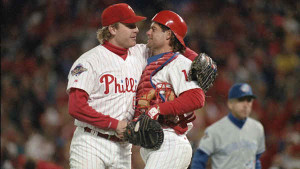

Curt Schilling, who logged the most innings pitched on the 1993 club, was an addition early in the 1992 season. Even with his stellar performance in 1992 that included an ERA+ of 150, the rotation was 19th in ERA. The bullpen was 24th.
With pitching as an obvious need for the team after the 1992 season, starter Danny Jackson was acquired from the Marlins in mid-November. Jackson, who had pitched in two World Series already (in 1985 and 1990), was the primary change to the rotation that offseason, as Schilling, Terry Mulholland, Ben Rivera, and Tommy Greene carried over into ’93. Jackson’s 3.77 ERA in 1993 contributed to a rotation ERA that ranked ninth in baseball, a marked improvement over the troubled 1992 team.
With the 1992 bullpen as weak and costly as it was, it was apparent that a number of upgrades could be made. The most fondly-remembered is likely Larry Andersen, who signed in December of 1992 and played for the Phillies at the age of 40 the next year. Andersen was a useful contributor to the pen in ’93 but, when asked why the team sought him out, he explained, “I think they needed a mediocre player in the twilight of his career.”
Shortstop was another spot on the diamond that bogged the Phillies down in 1992. Juan Bell saw most of the time there but slashed .204/.292/.259. He was worth an unbearably low OPS+ of 58 which, even at a position that allows good defense to mask poor offense, isn’t what a good team’s shortstop would produce. Others who spent time in the role – Dale Sveum, Kim Batiste, and Joe Millette – struggled just as much, with none managing an on-base percentage above .271.
In 1993, the Phillies promoted from within to fill this gap: Kevin Stocker, a rookie the Phillies drafted in 1991, would lead the club in batting average (min. 300 PA) by hitting .324.
Right field was another glaring weakness in 1992. Fangraphs’ WAR leaderboards rank the Phillies right fielders last in the league, which can be attributed mostly to Ruben Amaro Jr., who played the most innings there. Every part of his slash line – .219/.303/.348 in 126 games – was below what he averaged over the course of his unspectacular playing career. Wes Chamberlain, who also spent considerable time in right, was a replacement-level player.
Per Fangraphs, the two combined for 0.7 fWAR, which is what led the team to sign Jim Eisenreich as a free agent before the start of the 1993 season. He would go on to more than triple that production, reaching 2.2 fWAR. Qualms over WAR aside, Eisenreich was a clear upgrade between seasons that allowed a weaker roster spot to be held down capably while the team’s bigger stars could do the heavy lifting.
The 1992 club had a core that likely out-produced what many expect from the 2017 team’s budding core, but the two teams do have circumstances in common. The ’92 team is a reminder that bad teams need more than just one upgrade before they can be expected to contend, and 2017 will be another year to spend studying exactly which upgrades will be needed. The club will need to decide which players can be depended upon for their soonest World Series run and which could be holding them back from reaching it.